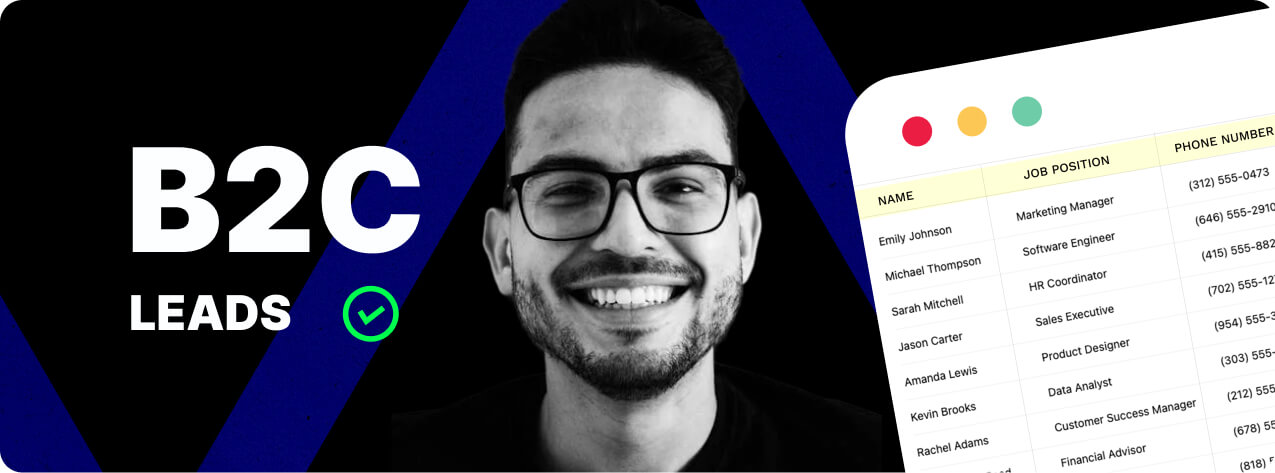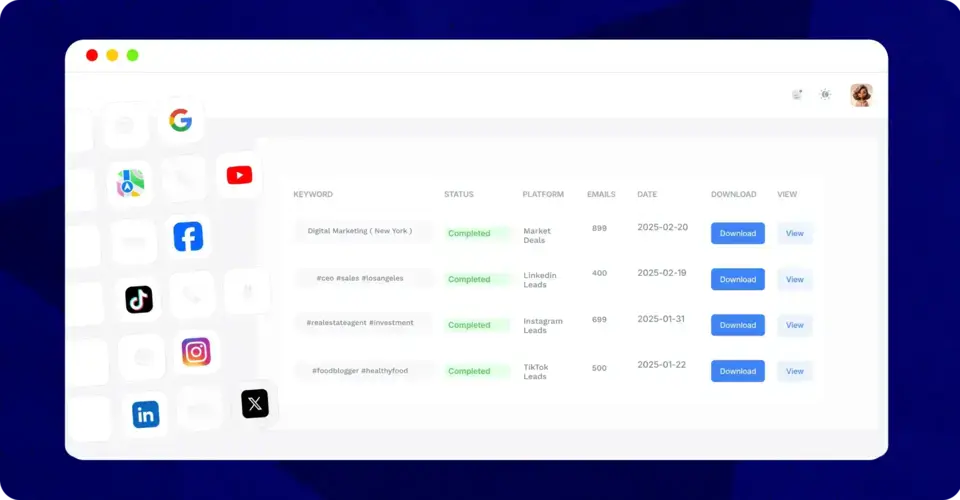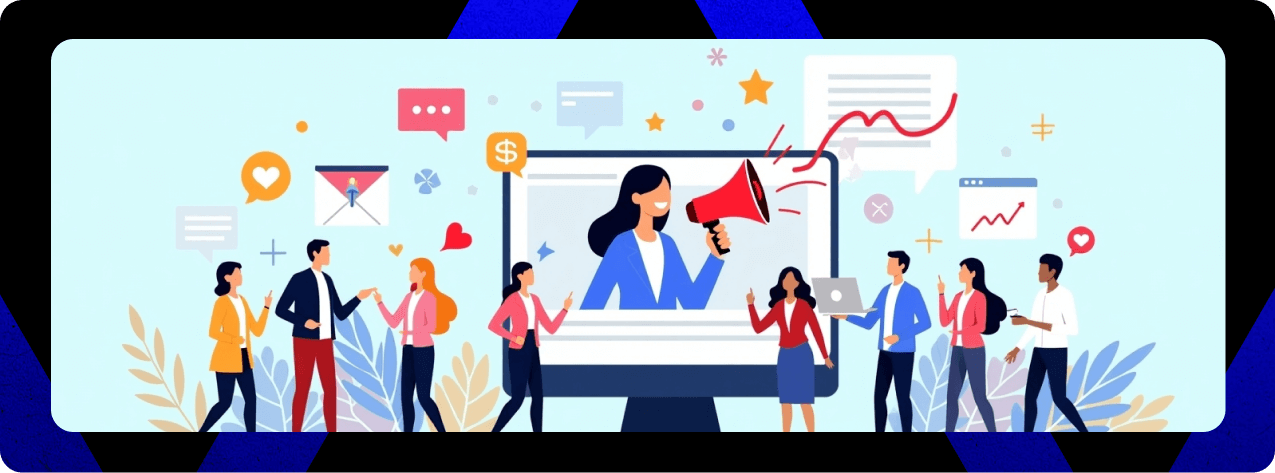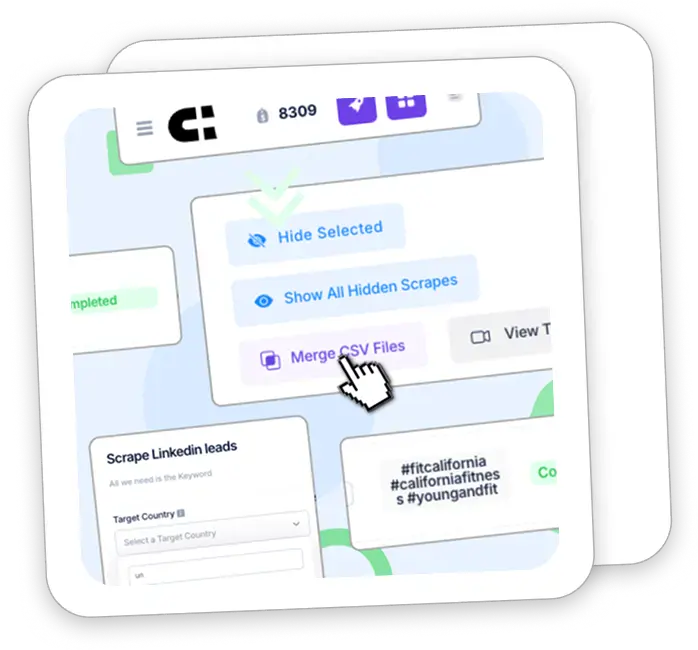B2C Lead Generation: The 2025 Playbook

In today’s hyper-digital world, B2C lead generation is less about casting a wide net, and more about appearing in the right place, at the right time, with the right message. Consumers don’t want to be sold to.
They want to discover, explore, and connect. It’s about customers finding your brand organically — not pushing messages that feel intrusive. If your brand doesn’t enter that conversation naturally, you’re getting left behind.
Whether you’re selling skincare products, personal finance tools, online courses, or mobile apps, generating high-quality B2C leads in 2025 means going beyond old-school tactics like cold emails or generic ads. You need channels that scale, messaging that resonates, and data that helps you reach real people, not just clicks or impressions. This is the foundation of effective B2C lead generation in 2025.
In this guide, we’ll break down everything you need to know to generate B2C leads effectively, from organic techniques and paid media to modern B2C lead generation services, lead scraper tools, and outreach platforms. We’ll also cover how platforms like IGLeads.io help businesses collect actionable consumer data through compliant scraping from sources like Instagram, Google Maps, and Facebook, helping you reach local buyers, niche audiences, and hard-to-find prospects without relying on bloated databases or pricey enterprise tools.
Let’s dive in.
What is B2C Lead Generation and Why It Matters in 2025
B2C lead generation is the process of attracting and capturing the interest of individual consumers who are likely to purchase your product or service. Unlike B2B (business-to-business), business to consumer lead generation targets everyday individuals — shoppers, app users, parents, and more.
At its core, B2C lead generation is about creating interest at the consumer level and guiding that interest toward action, usually a purchase, signup, or inquiry. That could mean:
- Getting someone to sign up for a free trial or newsletter
- Encouraging a product demo or discount code redemption
- Driving traffic to an online store or landing page
- Collecting phone numbers, emails, or social profiles for retargeting
But not all leads are equal. A consumer might give you their email and never engage again. Others might buy once and never return. That’s why modern B2C lead generation is focused not just on quantity, but intent, personalization, and timing.
⚠️ Important note: B2C leads tend to have shorter buying cycles, lower price points, and more impulsive behaviors than B2B leads, so your B2C lead generation strategy must be faster, more visual, and more emotionally engaging.
Whether you’re selling directly through social media, driving traffic via SEO, or scraping consumer data with tools like IGLeads.io, the key is the same: understand your audience’s behavior and build lead funnels that feel natural to them, not forced.
B2C vs B2B Lead Generation: Key Differences to Build Better Campaigns
Many marketers still lump B2C and B2B lead generation into the same bucket, but the difference in approach is massive. If you try to apply B2B tactics to a B2C audience, you’ll often come off as too slow, too formal, or completely irrelevant.
Let’s break down the key differences:
| Factor | B2C Lead Generation | B2B Lead Generation |
|---|---|---|
| Target Audience | Individual consumers | Company stakeholders or decision-makers |
| Buying Cycle | Short, often impulsive | Long, involving multiple steps and approvals |
| Emotion vs Logic | Emotion-driven (desire, FOMO, lifestyle) | Logic-driven (ROI, efficiency, compliance) |
| Channels | Social media, influencer marketing, paid ads, SEO | LinkedIn, cold outreach, webinars, whitepapers |
| Messaging Style | Conversational, visual, fast | Detailed, professional, trust-building |
| Sales Funnel | Direct to purchase | Nurture leads over weeks/months |
In 2025, these differences are even more pronounced. The average consumer expects a frictionless experience, they’re willing to give you their info or money, but only if it feels easy, personalized, and instant.
This is why B2C lead generation leans heavily on:
- Mobile-first experiences (think TikTok ads or Instagram DMs)
- Instant gratification offers (like one-click coupons or flash sales)
- Automated, but human-feeling outreach
- Scraped consumer data from public profiles and business listings
For example, tools like IGLeads.io let you automatically collect leads from Instagram bios, Google Maps business pages, or Facebook pages, letting you skip the time-consuming manual search and instead focus on personalized follow-ups.
If your B2C lead gen strategy isn’t tailored to these realities, you’ll struggle to compete.
B2C Lead Generation Strategies That Work in 2025
Consumers today are bombarded with options, ads, and messages so strong content marketing is essential to attract attention and build trust. To cut through the noise and consistently generate quality leads, you need a strategy that blends email marketing and social media, content, and data scraping. Below are the most effective B2C lead generation techniques working right now in 2025.
1. Social media outreach (Instagram, TikTok, Facebook)
Social platforms are still the top-performing channels for B2C lead gen. But it’s not just about running ads, it’s about meeting your audience where they already hang out and using the right message format.
What works:
- Scraping public profiles and bios to find potential customers
- DM automation or reply-based workflows
- Short-form video content with a CTA
- Creator/influencer shoutouts for lead magnets or giveaways
Example: Using IGLeads.io, you can pull Instagram bios that mention specific interests or locations, like “personal trainer in LA” or “small business owner.” That gives you a direct line to niche consumer audiences.
2. Google Maps scraping for local B2C leads
If you sell services or products locally, beauty, wellness, fitness, repairs, real estate, Google Maps is a goldmine. You can extract business info like emails, phone numbers, and websites, then segment by neighborhood, city, or service category. These tools allow you to pull data from a large number of listings in minutes, giving you instant outreach scale.
Why it works:
- People trust local providers
- You’re targeting people already in buying mode
- Easy to personalize outreach (mention location or reviews)
3. Paid lead generation services and databases
Plenty of providers offer B2C lead lists, but most fall short, outdated emails, missing data, or contacts that never opted in. Still, there are reliable B2C lead generation services that can deliver results if you use them wisely.
Later in this guide, we’ll break down the best B2C lead generation companies to consider in 2025.
4. Lead magnets and landing pages
Classic but effective, B2C lead generation tactics like lead magnets offer something valuable in exchange for contact info. The difference in 2025 is that your offer needs to feel instant, visual, and frictionless.
Winning lead magnets include:
- Mobile coupons or QR-based discounts
- Free samples or shipping
- Short, personality-based quizzes
- Limited-time giveaways or entries
Pair that with a fast-loading landing page and a clear CTA to build an email list of motivated, high-intent consumers, and you’ve got a reliable way to pull in B2C leads daily.
The difference in 2025 is that your offer needs to feel instant, visual, and frictionless — essential ingredients for a high-converting B2C lead generation campaign.
5. Organic content with high purchase intent
SEO for B2C is competitive, but search engine visibility remains a key pillar of scalable B2C lead generation, especially when ranking for keywords with buying intent, especially for niches like supplements, beauty, sports, parenting, and tech.
Examples:
- “Best collagen powder for skin 2025”
- “Top 10 baby monitors for travel”
- “Cheap but good electric scooters under $300”
Use blog posts, comparison pages, or product reviews to capture searchers at the moment they’re ready to buy or subscribe.
Top B2C Lead Generation Companies and Platforms for 2025
If you’re a B2C company without internal bandwidth to build funnels, outsourcing to a trusted provider can fast-track your results. But not all providers are created equal. Some sell recycled or low-intent data. Others charge enterprise rates for what’s basically a static list.
Here are some of the best B2C lead generation services and platforms in 2025, broken down by use case.
1. IGLeads.io
Best for scraping niche, local, and social media leads
IGLeads isn’t a traditional lead provider. Instead of selling pre-made lists, it lets you collect B2C leads directly from platforms like Instagram, Facebook, and Google Maps. You choose the source, the niche, and the filters. The result: fresh, relevant contact data that matches your audience.
Key features:
- Instagram bio and profile scraper
- Google Maps scraper for local business emails and phones
- Facebook page scraper
- Cloud-based, no browser plugins required
- Pay-as-you-go, no subscription lock-in
Ideal for: Brands targeting creators, small business owners, influencers, shoppers, niche interests, and geo-targeted segments.
2. LeadsBridge
Best for syncing B2C leads from ad platforms
LeadsBridge isn’t a lead provider, it’s a connector. It syncs leads from your Facebook, Google, and TikTok ads directly into your CRM or email platform. If you’re running paid ads for B2C offers, it helps maintain your workflows tight.
Best features:
- Ad lead sync automation
- Custom audience syncing
- Integration with CRMs like HubSpot, ActiveCampaign, and Mailchimp
Ideal for: Advertisers scaling B2C lead generation campaigns with multi-platform lead flows.
3. UpLead
Best for consumer emails in professional contexts
UpLead is usually seen as a B2B tool, but it also offers B2C targeting filters like industry, location, job title, and personal emails. It’s more polished than cheap list resellers but best suited to higher-ticket B2C products like coaching, software, or luxury services.
Pros:
- Clean, human-verified contact data
- Filters for job role and email type
- Integrations with CRMs and outreach tools
Ideal for: B2C offers that target professionals outside work, like productivity apps, financial services, or upskilling platforms.
4. BoldLeads
Best for real estate lead generation
BoldLeads specializes in generating home buyer and seller leads. They offer done-for-you landing pages, lead forms, and local targeting campaigns. It’s widely used by real estate agents and brokerages looking for exclusive B2C leads.
Pros:
- Exclusive ZIP code targeting
- Built-in CRM and autoresponders
- Dedicated support
Cons:
- Expensive for smaller agents
- Less useful outside real estate
5. LeadJig
Best for finance and insurance verticals
LeadJig focuses on appointment-based leads for financial advisors, Medicare agents, and insurance providers. Their platform combines direct mail, call center, and digital strategies to drive real consumer interest.
Best features:
- Real-time reporting
- Appointment booking funnels
- Multichannel outreach
Ideal for: Highly regulated industries where compliant consumer data and appointment setting is key.
How to Choose the Right B2C Lead Generation Service
Not all lead generation services are upfront about what they offer. Some sell the idea of “high-quality leads” but deliver old spreadsheets scraped years ago. Others give you volume but no relevance. Before committing your budget, use these criteria to evaluate whether a B2C lead generation company is actually worth your time.
1. Where does the data come from?
Always ask about the source. Is the lead data scraped in real-time? Purchased from third parties? Opted-in through a campaign?
For example, IGLeads.io allows you to scrape data directly from Instagram, Google Maps, or Facebook pages, so you always know the context and freshness.
Avoid any provider that’s vague or defensive about how they collect their leads.
2. Can you filter by intent or relevance?
More leads doesn’t mean better leads. You want leads that are:
- In the right location
- Interested in your product category
- Able to buy now or soon
- Responsive to outreach on email, phone, or social
If a service doesn’t let you filter by niche, behavior, or platform, it’s likely too broad to be useful.
3. Is the pricing transparent?
Watch for red flags like:
- High setup fees
- Required annual contracts
- “Minimum monthly spend” rules
- Hidden charges for exports or CRM integrations
A good B2C lead generation service will show you clear pricing upfront. IGLeads.io, for example, uses a pay-as-you-go model with no long term contracts, which is ideal for startups and lean teams.
4. Is the data compliant?
This is critical. You need to make sure your provider complies with data privacy laws like:
Reputable tools won’t promise “opt-in” leads unless they have proof. That’s why some users prefer scraping public data from platforms where the info is already visible, it lowers legal risk when used responsibly.
5. What support or documentation is offered?
If you run into issues with list quality or formatting, you’ll want responsive support. Look for services that provide:
- Email or live chat support
- Help docs or setup tutorials
- Clear refund or replacement policies
And if they don’t offer a free trial or sample data, that’s often a red flag.
How to build your own B2C How to build your own B2C lead generation funnel
generation funnel
If you want consistent, scalable leads without depending entirely on outside providers, building your own B2C funnel is the best move. You get full control over targeting, messaging, and follow-up, and you learn what actually converts.
Here’s a step-by-step breakdown of how to build a lean, high-performing B2C lead gen funnel in 2025.
Step 1: Define your audience
Get specific. General targeting like “young adults” or “homeowners” isn’t enough. Break it down by:
- Age range
- Location
- Interests or online behavior
- Purchase intent or problem they want to solve
- Where they spend time (Instagram, TikTok, Google, forums, YouTube, etc.)
Example: “Women aged 25–40 in Florida interested in holistic wellness and skincare, following natural beauty influencers on Instagram.”
Step 2: Choose your lead source
Pick a channel that aligns with how your audience behaves. In 2025, the best B2C lead sources are:
- Instagram/Facebook profiles (via IGLeads.io scraping tools)
- Google Maps businesses (especially for local services or referrals)
- Organic search (via blog posts, review articles, landing pages)
- TikTok or YouTube ads (if your product is visual or demo-based)
- Influencer campaigns (with lead magnets or free trials)
Avoid wasting time on platforms your buyers don’t use.
Step 3: Create a compelling offer
This is the biggest reason someone will give you their email, phone number, or click. Your offer must feel:
- Easy to access
- Valuable right now
- Relevant to your niche
Examples:
- A 10% off coupon code for a skincare product
- A quiz to match users with the right product bundle
- A giveaway entry for a high-value prize
- A free download, template, or mobile app trial
Make sure the offer is positioned at the top of your landing page or ad, don’t bury the lead.
Step 4: Build a fast, mobile-friendly landing page
In B2C, you have seconds to capture attention. Your landing page should:
- Load in under 3 seconds
- Be scrollable with your thumb
- Have one clear CTA (email input, button, tap-to-call)
- Include trust signals (testimonials, reviews, ratings)
- Feature quality images that reflect your brand identity and inspire confidence
If you’re scraping leads with IGLeads or another tool, this step becomes your follow-up destination, where you send leads you’ve collected.
Step 5: Automate follow-up and nurture
Once you have the lead, what happens next?
Use email campaigns, SMS, or even Instagram DMs to follow up quickly and drive action. Your first message should:
- Be short and personal
- Include links to helpful video tutorials that showcase your product or service
- Reference their interest or action
- Offer one clear next step (redeem a discount, book a call, watch a demo)
Tip: Use tools like Mailchimp, Lemlist, or Instantly to build drip campaigns and track open rates.
Step 6: Test, optimize, repeat
Every B2C lead generation funnel can be improved. Once you’re running, track:
- Conversion rates (visits to signups)
- Open and click-through rates (emails or SMS)
- Lead quality (do they actually buy?)
Tweak your copy, offer, or channel until you see real traction and consistently generate more leads from your funnel. The best B2C funnels are built through testing, not guessing.
Why IGLeads is a Must-Have for B2C Lead Generation in 2025
B2C lead generation in 2025 isn’t about chasing volume, it’s about relevance, timing, and delivery. Whether you’re scraping data with tools like IGLeads.io, building your own funnels, or working with a lead gen service, the key to successful lead generation is simple: meet real people where they already are, and give them a reason to respond.
Keep your outreach personal, your offers clear, and your funnels fast, and your B2C lead generation will thrive.
Explore more lead generation strategies and tools
- B2B Lead Generation Solutions – Guide for 2025
- How to Build a High-Quality B2B Email List for Outbound Marketing
- Buy Email Lists for Marketing in 2025: Complete Guide to Business Leads
- Why Scrape Google Maps? Use Cases for Sales, Marketing & SEO
- 15 Best Lead Generation Companies for 2025
- Best B2B email list providers in 2025
- Top Lead Generation Agencies Compared (2025)
- 18 Best B2B Lead Generation softwares in 2025
- Lead Generation Guide: Strategies & Tools for 2025
Find your email list by industry
- Get Fresh Veterinarians Email List 2025
- Get Fresh Chief Revenue Officers Email List 2025
- Get Fresh Banking Email List 2025
- Get Fresh Real Estate Email List 2025
- Get Fresh VP Email List 2025
- Get Fresh Retail Industry Email List 2025
- Get Fresh Chief Sales Officer Email List 2025
- Get Fresh Hospitals Email List 2025
- Get Fresh Healthcare Email List 2025
- Get Fresh Restaurant Email List 2025
- Get Fresh Chiropractors Email List 2025
- Get Fresh Hotels Email List 2025
- Get Fresh COO Email List 2025
- Get Fresh Contractors Email List 2025
- Get Fresh IT Decision Makers Email List 2025
- Certified Public Accountants Email List 2025
- Get Fresh Real Estate Agents Email List 2025
- Get Fresh Insurance Agents Email List 2025
- Get Fresh Mining Industry Email List 2025
- Get Fresh Chief Information Officers Email List 2025
- Get Fresh Pharmacists Email List 2025
- Engineers Email List: Reach Your Target Audience with Precision
- Get Fresh Mortgage Brokers Email List 2025
- Get Fresh HR Email List 2025
- Get Fresh Attorneys Email List 2025
- Oil And Gas Industry Email List 2025
- Chief Marketing Officer Email List 2025
- Email Extractor Ultimate Guide 2025
- CFO Email List – Get Targeted CFO Contacts in 2025
- How to Get a Homeowner Mailing List in 2025?
- Realtor Email List 2025
- Dentists Email List 2025
- Get Fresh CEO Email List 2025
- Marketing Directors Email List: How to Build and Use One for Your Business
Frequently Asked Questions
Using scraping tools like IGLeads.io to pull contact data from Instagram, Google Maps, or Facebook pages is one of the fastest ways to build a niche B2C lead list. You can target specific industries, keywords, or locations and reach out the same day.
Buying leads is quick, but quality and intent often suffer. Generating them yourself — through landing pages, social outreach, or scraping — takes more effort but gives you control over targeting, messaging, and context. The leads are typically fresher and more responsive.
It depends on your offer. B2C leads usually have lower price points and faster decision-making, which means a higher volume but lower value per lead. In contrast, B2B leads take longer to close but can be worth thousands. Your lead gen approach should match your business model.
Scraping publicly available data (like business emails or social media bios) is generally legal in many jurisdictions, but how you use the data matters. Always follow privacy laws like GDPR, CCPA, and CAN-SPAM. Tools like IGLeads.io help users stay compliant by only scraping data that’s already public.
There’s no magic number. A small list of highly relevant, responsive leads is better than thousands of random ones. Focus on targeting, not just volume. Track how many leads convert to customers and optimize from there.
At a minimum, you need a landing page or offer, a way to collect leads (like forms or a scraping tool), a follow-up system via email or SMS, and basic tracking tools like Google Analytics or a CRM. If you’re scraping leads, IGLeads.io helps you extract clean, niche contact data from public platforms.
You’ll know it’s working if leads are converting into customers, your cost per lead is sustainable, and you’re getting positive responses or engagement. If leads are ignoring your messages, revisit your targeting, offer, or outreach strategy.



